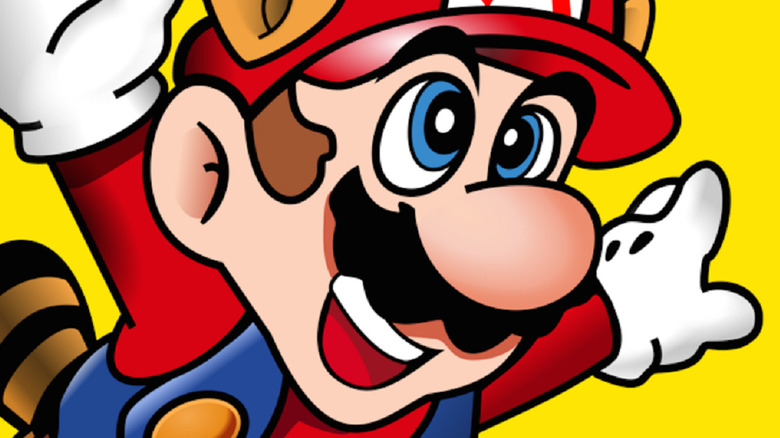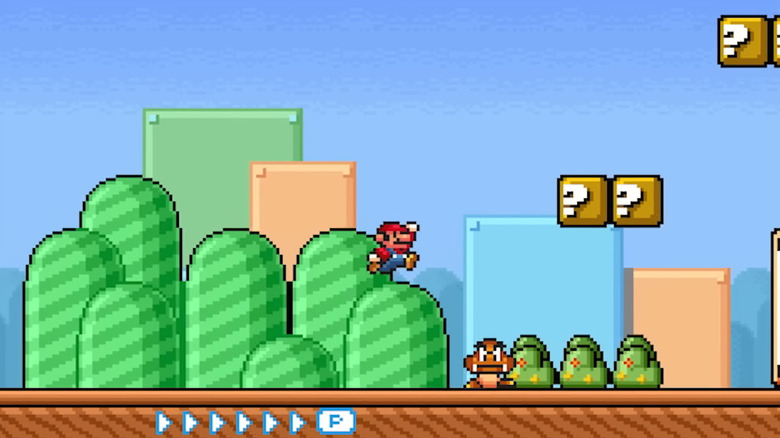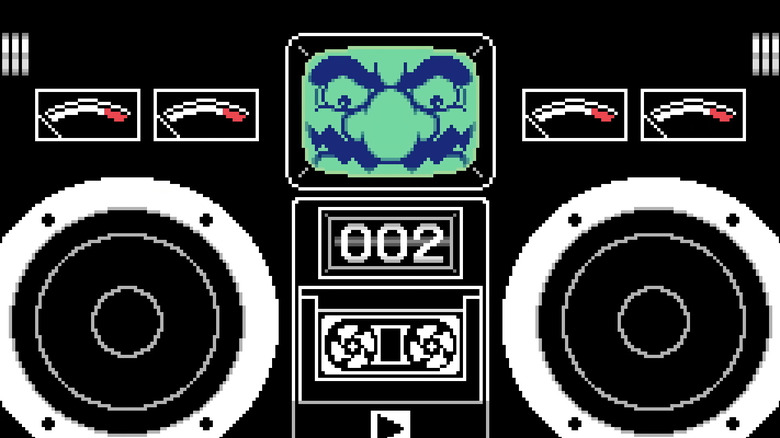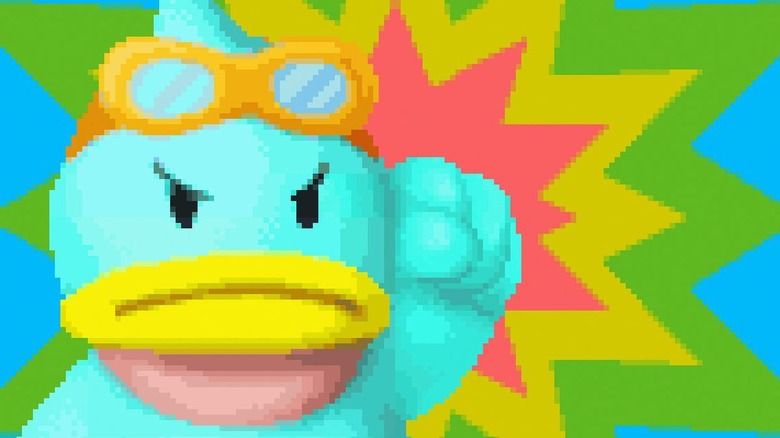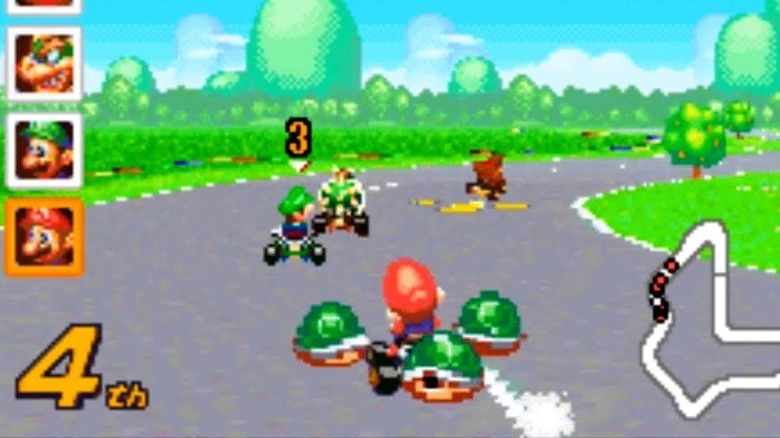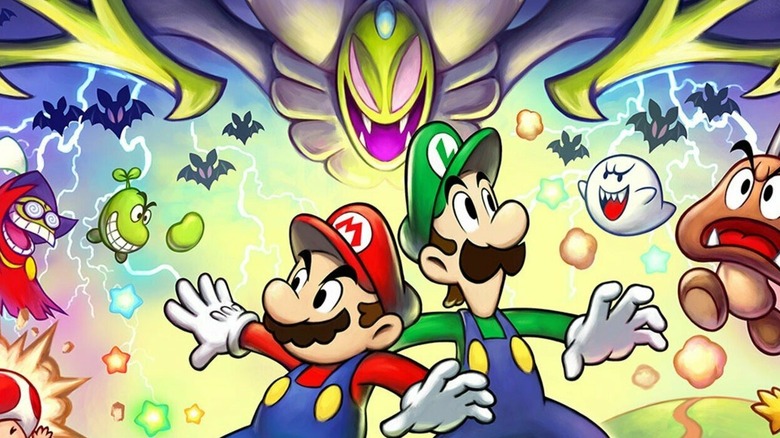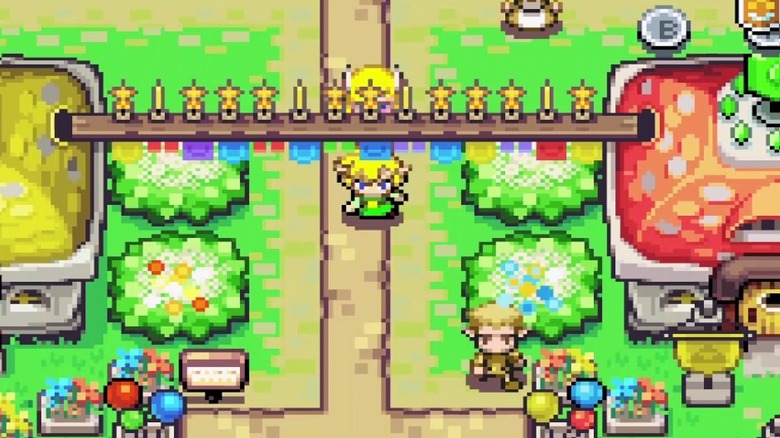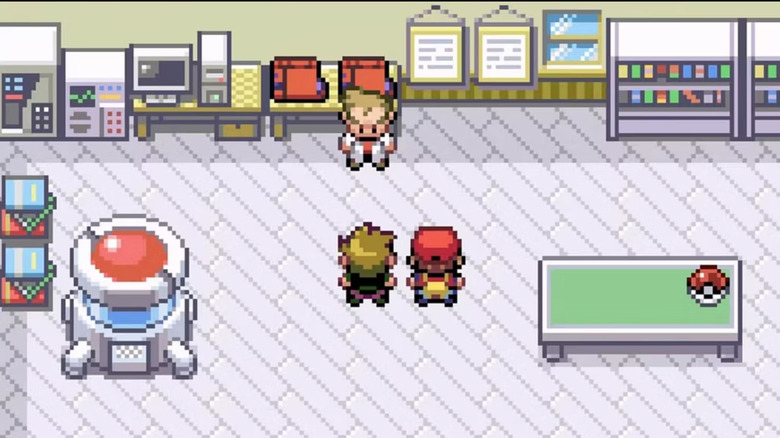Every Day One Game Boy Advance Game On Nintendo Switch (And One We Really Miss)
Nintendo is famously against third-party emulation. Many gamers have criticized this stance, as it can sometimes be hard to snag classic games for older systems, and there are many games that haven't seen a glossy reissue. Thankfully, Nintendo has brought back some of its classic games to modern hardware via the Nintendo Switch Online service and its Expansion Packs. For example, recently, gamers were treated to "GoldenEye 007" on the Switch, even though the quality of the port was questionable.
Now Nintendo is rolling out a new Game Boy Advance Expansion Pack for the Switch. The Game Boy Advance is still one of the most beloved handheld consoles of all time, so this is certainly a welcome addition. It improved upon the original Game Boy and Game Boy Color in many ways, offering sharper graphics and larger games. The first batch of games being brought to the Switch are certainly exciting, but it's hard to ignore that one of the most popular games from the system is missing.
Here's what to expect from the GBA Expansion Pack — and one game we can't believe Nintendo left out.
Super Mario Advance 4: Super Mario Bros. 3
One of the most exciting Game Boy Advance titles coming to Nintendo Switch Online + Expansion Pack is "Super Mario Advance 4: Super Mario Bros. 3." This, as the title suggests, is remake of the 1988 classic "Super Mario Bros 3," a game many consider one of the Mario games of all time. The game features eight worlds to explore and more than enough Koopa family members to smash. Players also have access to a ton of power-ups, such as the Super Leaf, Tanooki Suit, and Frog Suit. Not only does this remake pack in all the fun of the original game and updated graphics, but it also features some additional goodies.
Some of the mechanics from the original title have been tweaked in this version to function similarly to "Super Mario World," including the ability to carry items into pipes and new ways of increasing Mario's speed. Additionally, content previously locked behind e-Reader cards. Some of the notable exclusives include giving players access to new levels and the Cape Feather from "Super Mario World."
WarioWare, Inc.: Mega Microgames!
Nintendo isn't just letting Mario have all the fun. His rival, Wario, lands on the Switch in "WarioWare, Inc.: Mega Microgames!" The first title in the "WarioWare" series, "Mega Microgames!" takes players through a myriad of addictive minigames, each of which are weirder than the last and typically take four seconds max to complete. In other words, "Mega Microgames!" established the wild formula of the series right away.
There are over 200 microgames in total, varying in skill level and strangeness. For example, some games require the player to press one button with precise timing, while another may see the player balancing a character using only the D-pad. The game also debuted a diverse cast of new characters to the Wario corner of the world, including a blue-haired dancer named Jimmy T. and a mysterious alien known as Orbulon, just to name a few.
Kuru Kuru Kururin
"Kuru Kuru Kururin" is a game that's less well-known than some Game Boy Advance games just added to the Nintendo Switch Online service as it was never released in North America. The concept is simple: players control something like a helicopter that slowly spins as they race through a number of obstacle-filled levels. The title "kuru kuru" is a crude onomatopoeia derived from the sound a helicopter's blades make, while "kururin" comes from a toy of the same name that can be spun in a similar way to the player's vehicle in-game.
The game features a pixelated and vibrant aesthetic that will bring players straight back to the 2000s. But appearances aren't everything, and its surprisingly complex gameplay will keep players engaged, as will its cheesy but lovely story about saving your family and learning how to be more confident — all by piloting what is essentially a rotating rectangle.
As players go through the obstacle courses, they lose time for hitting the sides or obstacles in the way. It starts off simple and there's a tutorial that teaches the basics, but after a few levels, it suddenly becomes much more difficult. Players have to stay on their toes to avoid crashing into the colorful surroundings. Even after every level is complete, there's still plenty of challenges and special game modes to try in "Kuru Kuru Kirin."
Mario Kart: Super Circuit
"Kuru Kuru Kururin" is a unique casual racing game, but it's far from the most well-known series in the genre. That top spot probably goes to the "Mario Kart" games. With the Game Boy Advance being added to the Nintendo Switch Online package, players get to race into "Mario Kart: Super Circuit," historically the only entry released on the Game Boy Advance after "Mario Kart XXL" was rejected. Its graphical style is closer to the original "Mario Kart" for the SNES than the more recent "Mario Kart 64," as the handheld system didn't have the 3D capabilities of the Nintendo 64.
"Mario Kart: Super Circuit" introduced the concept of retro stages to the series with its inclusion of every single map from the original "Super Mario Kart," and it also allowed players to share ghost racing data for the first time. It was the first game in the series to have true multi-console multiplayer via the use of a link cable, and it even worked with just a single cartridge and up to four players. There were fewer options if only one player had the game, but nonetheless it proved the series could work on a handheld platform.
Fans of this landmark GameBoy Advance racer will have a field day with its online multiplayer, which is made available through the Nintendo Switch Online service. Even gamers of "Mario Kart" who never got to try this entry will appreciate it, if for no other reason than to see how far the series has come in the last 20 years.
Mario & Luigi: Superstar Saga
The "Super Mario" franchise stayed away from the RPG genre in the early days, for the most part. And that remained true until the release of "Super Mario RPG: Legend of the Seven Stars" for the Super Nintendo, a lauded game that proved Mario could move away from sports and platformers and explore narratives with turn-based mechanics. After the success of "Paper Mario" cemented the character's potential in the genre, in 2003, the GameBoy Advance received a spiritual successor to "Super Mario RPG" in the form of "Mario and Luigi: Superstar Saga."
"Mario and Luigi: Superstar Saga" follows the two brothers as they traverse the Beanbean Kingdom — that's actually its name — to rescue Princess Peach's voice. It's an RPG through and through, complete with XP and leveling, equipment, abilities, and its own unique approach to turn-based combat. It's one of the prettiest games for the Game Boy Advance, too, with a highly saturated color palette and smooth pixel art that, somehow, still makes everything stand out.
"Mario & Luigi: Superstar Saga" is a must-play for "Mario" fans who've never seen him outside of his element, but it's not exactly a casual experience — be prepared to face down enemies with strategies that go beyond jumping on goomba heads (though that is still an option).
The Legend of Zelda: The Minish Cap
Although Mario and friends get quite a showing in this first round of Game Boy Advance games, Nintendo's other biggest tentpole franchise is represented solely by "The Legend of Zelda: The Minish Cap." Luckily for fans, this top-down adventure is an example of the series at its best. A prequel to "The Legend of Zelda: Four Swords," this game sees Link using the titular cap to modulate his size in order to enter new areas and solve problems in treacherous dungeons.
Though it has received some criticism for its relatively short length and lower difficulty level, "The Minish Cap" has also been praised for its lush level design, spectacular music, and clever size-changing mechanics. The game combines everything fans loved about "A Link to the Past" and "Wind Waker" into a tale that somehow never feels like it's borrowing too much from the past. IGN went so far as to say "The Minish Cap" is "worthy to sit among the best of the 'Zelda' best." If you've ever wanted to shrink Link down and run wild across a cobbler's table, this is the offbeat adventure you've been looking for!
But where's Pokémon Fire Red/Leaf Green!?
Not to be ungrateful, but there's a pretty massive franchise missing from the launch lineup of Game Boy Advance games on the Switch. The absence of either "Pokémon Fire Red" and "Leaf Green" — remakes of the first two Pokémon games with enhanced visuals and a drastically expanded campaign — feels like a huge oversight.
Sure, the Game Boy Advance era also marked the arrival of "Ruby," "Sapphire," and "Emerald," which introduced the Hoenn region and baddies like Team Magma and Team Aqua. Even so, "Fire Red" and "Leaf Green" still feel like the logical place to start if you're introducing GBA "Pokémon" games to a new platform. Not only do you get a retelling of the story that started it all, but the remakes also add new twists to the journey, including a whole new set of islands to explore and another counterattack from the villainous Team Rocket.
It's easy to see why this pair is frequently seen as being among the best "Pokémon" games of all time. What's not easy to see is why the Nintendo Switch is launching a collection of GBA games without them. Still, it's worth remembering that "Pokémon Stadium" eventually arrived on the platform's subscription service — so there's still hope!

